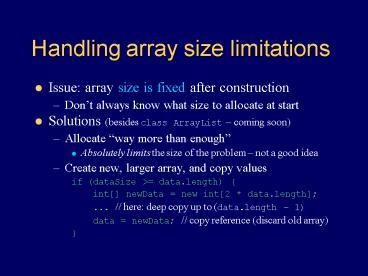Handling array size limitations PowerPoint PPT Presentation
1 / 12
Title: Handling array size limitations
1
Handling array size limitations
- Issue array size is fixed after construction
- Dont always know what size to allocate at start
- Solutions (besides class ArrayList coming soon)
- Allocate way more than enough
- Absolutely limits the size of the problem not a
good idea - Create new, larger array, and copy values
- if (dataSize gt data.length)
- int newData new int2 data.length
- ... // here deep copy up to (data.length
1) - data newData // copy reference (discard
old array)
2
More array techniques
- Finding a value
- int i 0, target (some number)
- boolean found false
- while (i lt x.length !found)
- if (xi target) found true
- else i
- if (found) ... // know target is at xi
- else ... // know target is not in x
- Removing an element 2 cases
- 1. If order doesnt matter, replace removed item
with last item - 2. Otherwise, must move all trailing items
forward one slot - Inserting an element same two basic cases in
reverse
3
Arrays of objects
- Arrays of objects require 3 steps to use
- Rectangle boxes // 1. declare array of
references - boxes new Rectangle3 // 2. instantiate array
- // 3. instantiate each object in the array
- for (int i0 iltboxes.length i)
- boxesi new Rectangle(5,5,5,5)
- Infinite applications
- Imagine Car myFleet ...
- Then for(...) myFleeti.draw(g)
- An alternative to parallel arrays
- i.e., not name100, scores100,10, grade100
- Better Student100 class Student name,
scores10, grade
4
Arrays of arrays
- Arrays store anything, including arrays!
- Not exactly multidimensional, but workable
- e.g., int table new int104
- A table of integers, with 10 rows and 4 columns
- table.length is 10
- Each tablei.length is 4, for all i
- Component array sizes can vary
- table2 new int6 // now 3rd row has 6
- Typically use nested for loops to process
- See TicTacToe.java (p. 299)
5
java.util.ArrayList
- An array-like data structure
- Fill with add method adds element to end
- Size is not fixed (grows dynamically as
necessary) - Also an insert method inserts element anywhere
- Specify position 0..size (like arrays) where
element goes - Use set and get methods to change and access
- Cannot use or notation like arrays
- New with Java 5 is a generic class
- Means type of elements are specified insures
all are same type - Before Java 5 (so still available) element type
is Object - So can store anything in a ArrayList, but must
cast before use - Also, compiler had no way to verify correct type
6
How to use ArrayLists
- Declare/create ArrayList (no need to size it)
- ArrayList a new ArrayList()
- Or with Java 5 can specify the type
- ArrayListltTgt a new ArrayListltTgt()
- // where T is an object type not a primitive
data type - Add objects to end, or set and get specific
objects - ArrayListltRectanglegt a new ArrayListltRectanglegt(
) - a.add(new Rectangle(5,5,5,5))
- Rectangle r a.get(0) // gets first
- a.set(0, new Rectangle(0,0,10,10)) // replaces
first - Simple insert and remove too
- a.insert(i, new Rectangle(1,1,1,1)) // inserts
in position i - a.remove(i) // removes element in position i
7
ArrayList and primitive types
- Must use wrapper classes for primitive data
types - Byte, Short, Integer, Long, Float, Double,
Character, Boolean - E.g., to store double values in list
- ArrayListltDoublegt list new ArrayListltDoublegt()
- list.add( new Double(17.64) ) // what really
happens - list.add( 0.74 ) // what Java 5 autoboxing
feature allows - Convert back to primitive type on retrieval
- double d list.get(0).doubleValue() // what
really happens - double d list.get(0) // with Java 5
auto-unboxing feature - Note additional step if type of list not
specified - double d ((Double)list.get(0)).doubleValue()
8
More java.util collections
- List actually an interface
- Defines a set of common methods like add, size,
iterator - Shared by ArrayList, LinkedList, and others
- Note Collections methods to manipulate List
objects - Collections.shuffle(list) // randomly shuffles
the list - Collections.sort(list) // assuming items are
Comparable - Stack a LIFO (last in, first out) data
structure - StackltStringgt s new StackltStringgt()
- s.push(dog) ... // push objects onto top of
stack - while (!s.isEmpty())
- ... s.pop() // removes/returns top
object - Also trees, sets, hash tables,
9
Modularity
- Also a structured programming topic
- Can replace a rectangle with a module
- Modules contain stacked/nested structures
- Java modules
- methods (the most basic modular units)
- classes (collections of related methods)
- packages (collections of related classes)
10
Using methods invoking
- Direct translation of algorithm e.g.,
- getData()
- process()
- showResults()
- In turn, the method process() might do
- result calculate(x, y)
- where calculate is another method, one that
returns a value based on x and y. - And so on
11
Note parameters are copies
- e.g., void foo(int x)
- x 5 // changes copy of the value
passed - So what does the following code print?
- int a 1
- foo(a)
- System.out.print(a a)
- Answer a 1
- Is it the same for references? Consider the
following - String s APPLE
- anyMethod(s)
- System.out.print(s) // prints APPLE
- Read advanced topic 9.1, pp. 334-335
12
But references are references
- A reference is used to send messages to an object
- e.g., void foo(Rectangle x)
- x.translate(5,5)
- // actually moves the rectangle
- Copy of reference is just as useful as the
original - i.e., although methods cannot change a reference,
they can change the original object - But only if the object is mutable
- Not an issue with immutable types a class with
no set methods like Strings

